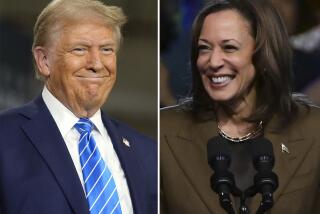Next President Will Likely Appeal to Center--Geographically Speaking
- Share via
For political junkies, the best thing about the arrival of 1999 is that it means the next presidential election is only one year away. And here’s an early tip: If you want to identify the roads that lead to the White House in 2000, forget about the Pacific Coast Highway or even I-95, the north-south lifeline of the Atlantic Coast, and cast your eyes inland.
In all likelihood, the next president will be picked by people living along highways such as I-75 in Michigan, Ohio and Kentucky, and I-70, rumbling west from Pennsylvania through Missouri. In 2000, the battle for the Oval Office is shaping up primarily as a battle for the heartland. “The Midwest,” says Scott Reed, Bob Dole’s campaign manager in 1996, “is where the action will be in 2000.”
Much, of course, isn’t yet known about the next presidential campaign. Like, say, the nominees. Or the economic conditions they will be competing under. Or the country’s attitude toward Bill Clinton once the Senate finally finds a way to close the Nosferatu scandal--the scandal that will not die.
But even with those inevitable uncertainties, presidential campaigns are always ripe for early speculation, even reasonably informed early speculation. The reason is that state voting patterns in presidential politics tend to change slowly, not suddenly--absent earth-shaking events such as a sharp economic downturn, or a war.
That fact means two things. One is that winning electoral college coalitions, once established, tend to endure until events or the parties themselves provide voters a reason to change allegiance. Franklin D. Roosevelt’s New Deal coalition allowed Democrats to hold the White House for 28 of the next 36 years, until the coalition was torn apart by Vietnam and the cultural strains of the 1960s; Richard Nixon’s “silent majority” coalition then allowed Republicans to control the White House for 20 of the next 24 years, until George Bush squandered it through inaction in the face of the early 1990s recession. Clinton’s two victories have now set the foundations of a “new Democrat” coalition that could, if it solidifies in 2000, undergird a sustained period of Democratic advantage in presidential politics.
The stability of presidential voting patterns has a second important implication: It means that losing campaigns sometimes trace the outline for winning campaigns that follow. Barry Goldwater performed that trailblazer role during his landslide defeat in 1964, pointing the GOP toward the Southern states that anchored the Nixon and Ronald Reagan majorities.
With much less fanfare, Michael S. Dukakis fulfilled the same role for Democrats in 1988. Compared to 1984, Dukakis improved the Democratic performance along an axis that ran from the Northeast through the upper Midwest to the West Coast. Clinton was then able to build on Dukakis’ inroads to capture most of those “northern tier” states in amassing his lopsided electoral college majorities in 1992 and 1996.
All of that suggests one way to start thinking about how Republicans might win back the White House in 2000 is to look at Dole’s 1996 showing. Republican planning will likely start with Dole’s base in the South and Mountain West, and then move on to the states where he came closest to Clinton.
Apart from the Southeast, that rules out most of the states with ocean views. Dole was crushed throughout the Northeast and mid-Atlantic states, and recent trends there offer the GOP little encouragement. As public views of the party have plummeted nationally after the House vote to impeach Clinton, the bottom has fallen out in the East: In the latest Gallup Organization Inc. survey, just 28% of Easterners expressed a favorable view of the GOP--numbers that put Republicans down with used car salesmen and reporters.
Though Dole was slightly more competitive along the West Coast, Republican prospects there don’t look much brighter. In the Gallup survey, attitudes toward the GOP were as negative in the West as in the East. And even though Republican planners are reluctant to write off California (partly because they need to raise money there), Reed acknowledges that after Clinton’s two resounding victories in the state, and the Democratic sweep last November, the GOP will have to take “a serious look” at whether it can afford to fully contest the nation’s biggest electoral prize in 2000.
Instead, the top targets for the GOP are likely to be the 10 states where Dole lost to Clinton in 1996 by single-digit margins. Two would probably be set aside at the outset: Oregon, which few Republicans really consider within reach, and Tennessee, the home state of Vice President Al Gore, the likely Democratic nominee.
For the GOP, the remaining list begins with Florida, a state Clinton surprisingly won last time and Republicans cannot afford to lose again. After Florida, the list quickly moves inland. It includes three mountain states where Clinton won narrowly: Nevada, Arizona and New Mexico. Then the list proceeds to the nation’s heart: the battlegrounds of Kentucky, Missouri, Ohio and Pennsylvania. Just outside the 10% mark is Wisconsin, another prime Midwestern target.
The parties may trade some other states around the edges. (If Texas Gov. George W. Bush is the GOP nominee, he’d be a good bet to bring back neighboring Louisiana, and this year’s huge black turnout can give Democrats hope of recapturing Georgia.) But if the race is close, this cluster of Midwestern states is likely to be the decisive ground between a Democrat strong on the coasts and a Republican rooted in the South and Mountain West.
On this Midwestern terrain, Republicans have more reason for optimism than along the coasts. With little notice, the Democratic congressional vote among white Midwesterners fell sharply last November--to just 40%, the lowest level outside the South. That means this flyover country could well be the prime real estate when the eventual Republican nominee selects his or her running mate.
One name to watch: Pennsylvania Gov. Thomas J. Ridge, a pro-choice Vietnam veteran whose state, with its 23 electoral votes, is one that Republicans need to win in 2000--but may not be able to win without some hometown help.
More to Read
Get the L.A. Times Politics newsletter
Deeply reported insights into legislation, politics and policy from Sacramento, Washington and beyond. In your inbox twice per week.
You may occasionally receive promotional content from the Los Angeles Times.










